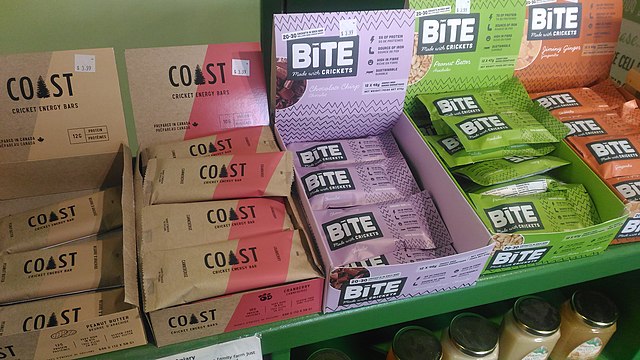
Can we eat insects? Yes. In fact, not only can we eat insects, but we should eat insects. They are nutritious, easy to grow, and not bad for the environment.
The average human needs between 1,600 calories to 3,000 calories, depending on our gender and our body size. Those calories need to be roughly 60% carbohydrates, 20% protein, and 20% fat. We also need minerals, vitamins, fiber, and a few other things. We can get more or less of these things depending on what we eat. Some diets have too many carbohydrates, some don’t have enough protein, and some diets are well balanced. Currently, our calories come from animal products, plants, fruits, and chemically created ultra processed foods that are not really food.
Most people in developed countries eat too much meat. This has health problems, but the negative impacts are environmental rather than health based. As the world population increases and more people in developing countries are lifted out of poverty, we need more and more meat. There are many environmental consequences of eating meat, but here are five of them. Livestock production accounts for 18% of all greenhouse gas emissions. Huge tracts of the Amazon rainforest, and other forests, are being cut down to make grazing land for cattle, which is a more lucrative industry for those countries. More than two-thirds of all the world’s agricultural land is devoted to growing food for all of the livestock in the world. Only 8% of the land is used to grow food that we eat. If the entire world starting eating as much meat as the developed world does, we wouldn’t have enough land on Earth to feed or farm these animals. Cows require an enormous quantity of water. An average cow drinks roughly 45 liters of water a day. If you have a farm with 10,000 cows, you need a staggering amount of water, which, thanks to climate change, is becoming scarce in many places. And, lastly, livestock are fed antibiotics to keep them healthy and help them grow, which is pushing the global antibiotic resistance problem.
So, if we stop eating meat, do we just eat plants? You can live a healthy life with just plants, but you have to eat certain things to get enough protein. It is far easier to get that protein from insects. There are currently over 1 million species of insects and a further 7,000 are discovered each year. Saving the poisonous and the bad tasting ones, we could eat a vast number of these insects. In fact, many countries already do eat insects as a matter of course. Wikipedia says that 2,096 different types of insects are eaten around the world. The most common are beetles and 696 different species of beetle are currently eaten. Grasshoppers and crickets are a delicacy in many countries.
Why don’t we eat insects in western countries. There are two reasons I can think of. We have the luxury of choice, and we associate insects with being dirty. Most of the countries where insects are eaten are developing countries and they don’t have or can’t afford meat. They need to get their protein from somewhere and they have eaten insects for millennia. In developing countries, we probably used to eat insects, but once we became wealthier, we stuck to meat. The second reason is people think insects are unclean and don’t like the sight of them. The thought of eating insects is repellent to many people. However, we eat shrimp, which look similar to insects. Depending on the insects, they can be very nutritious. 100 g of crickets has 484 kcal, 25 g of fat, 7 g of carbohydrates, and 56 g of protein. You could completely replace meat with crickets and be fine.
Insects are obviously much smaller than cows and you can grow 5,000 crickets in 30 cm2 of farming space. They are grown in plastic bins with soil and a water source at the bottom. 100 g of crickets is roughly 300 crickets. That means you can grow about 5 kg of crickets in 1 m2, and you could put the plastic bins on shelves and go vertical, increasing the number. Crickets reach full size in eight weeks, so you can grow 32.5 kg of crickets on every 1 m2 in a year. Crickets will also eat waste, so they are easier to feed. There are other insects that are even easier to grow.
The fact that people don’t want to eat insects can’t be ignored, but it is very easy to grind the insects into a flour that can be used to make other foods. That way, people can get their protein from insects without even knowing that they are eating insects. People say they don’t want to eat insects, but ultra processed food contains things that are far worse for us.
There are some questions over the welfare of the insects and whether they are sentient or not, but cows definitely are and we have no problem eating them. Insects are the only logical choice for the future. And this is what I learned today.
Image By Mateus S. Figueiredo – Own work, CC BY-SA 4.0, https://commons.wikimedia.org/w/index.php?curid=79351442
Sources
https://rethinkpriorities.org/publications/insects-raised-for-food-and-feed
https://beef.ces.ncsu.edu/water-for-beef-cattle
https://woods.stanford.edu/news/meats-environmental-impact
https://entomology.unl.edu/scilit/insect-diversity
https://time.com/5942290/eat-insects-save-planet
